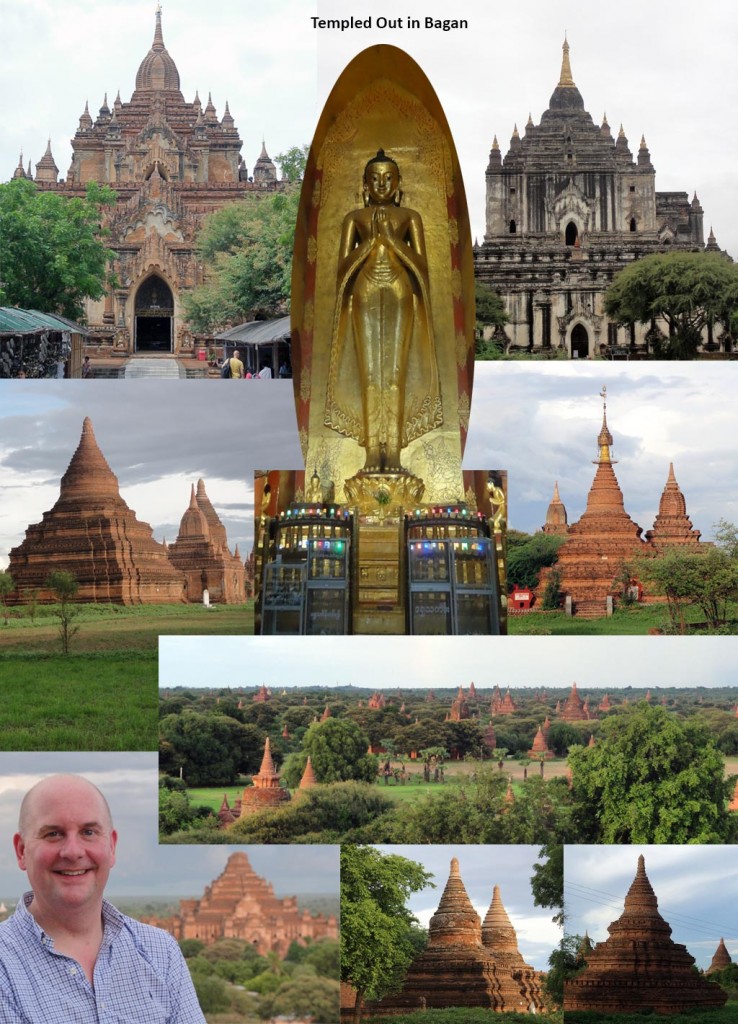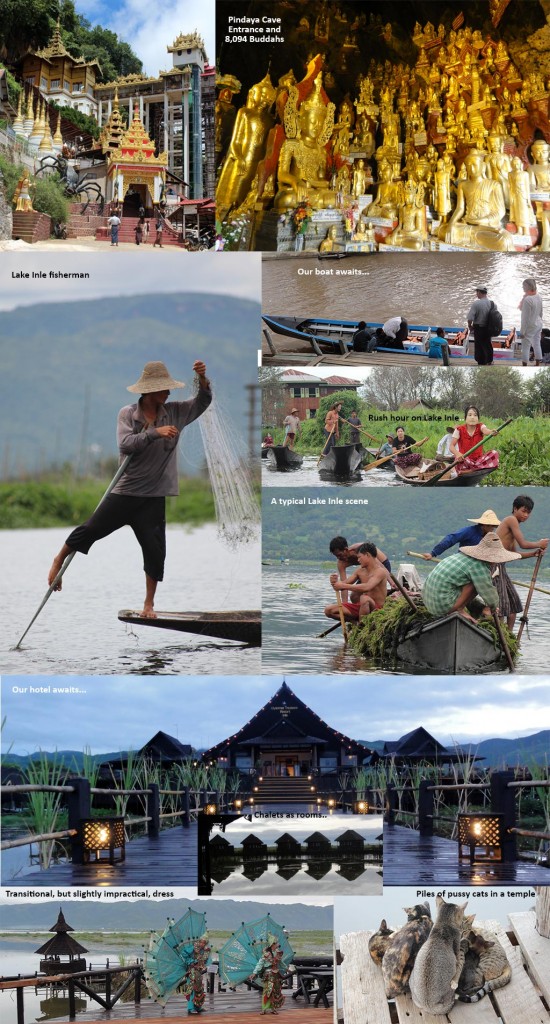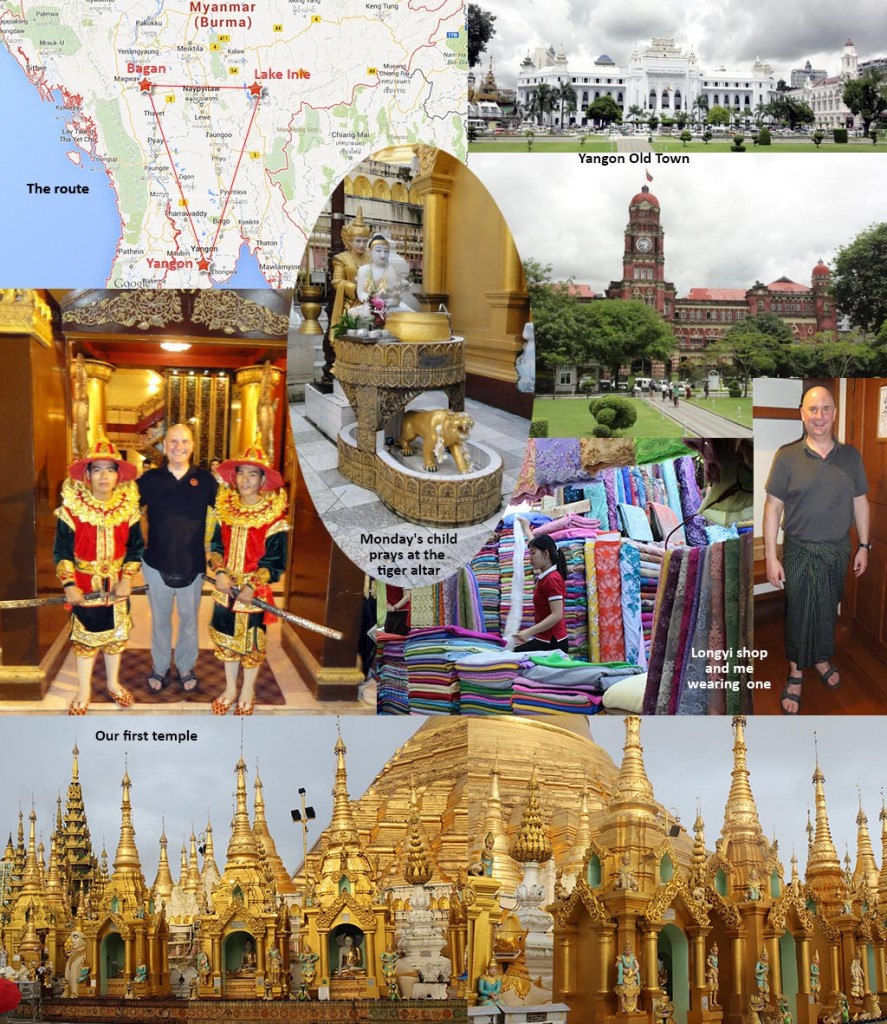My advice to anyone: Go to Myanmar – and go now. Although in its infancy, tourism has taken root and like an invasive species, is starting its strangle hold. The country has only really been open since the military junta was overthrown in 2011, and there still are no McDonalds, Burger Kings or KFCs (but the first is opening next month) and the Internet is intermittent at best. Who knows how long the local ladies in a temple will be prepared to share their delicious tea-based snacks with you or you will still be able to witness the amazed look of a child seeing their image captured on a digital camera for the first time. But I digress, let’s start at the very beginning.
The Republic of the Union of Myanmar, formerly Burma, is just a short hop from Singapore and offers the perfect opportunity for a short break. Our trip had 3 centers, Yangon (the former capital), Bagan (with its temples) and Lake Inle. In every location there was much to do, eat and see – especially the local dress – all the men wear practical skirts called longyi, which I took too like a duck to water, but like water off a duck’s back it slid off several times, so underwear was essential.
Yangon (formerly Rangoon)
Although no longer the capital, Yangon is by far the largest city in Myanmar and is experiencing a rapid change with construction everywhere, dwarfing the British colonial structures that are rapidly deteriorating. Our guide, Suu, met us at the airport and although he was a fountain of knowledge, it was not always that useful. On the way to our hotel, the questions kept piling up – why did the country’s name change from Burma to Myanmar? (Answer: astrologists told a general). Why the recent change from driving on right to left hand side of the road? (Answer: astrologists told a general). Why did capital move from Yangon to Naypyidaw? (Answer: astrologists told a general). How many temples are there here? (Answer: a lot). By that time we had arrived at the hotel.
After freshening up (in the lobby as our rooms were not ready), we jumped back in the car to visit our first pagoda located in the heart of the city. At the Shwedagon or Golden Pagoda we became familiar with more astrology as we admired the 99 meter high construction. Burmese do not have surnames, and can change their names at will. Typically, people stick to names that start with a letter assigned to the day of the week they are born, with the exception of Wednesday (really, I am not making this up) where it depends if you were born in the morning or afternoon. Each pagoda has 8 stations for people to pray at, depending on your birth day – I was born on a Monday, so I would pray at the tiger altar and my name would be something like Kan (ka being the typical start of name for a Monday child, and the fewer syllables the better). Wednesday morning people would be Lan and pray at the tusked elephant altar, Wednesday afternoon, Yan, and you’d be at the tuskless elephant altar. Additionally, Monday, Wednesday Thursday and Friday are considered to have a benign planetary influence. Again, I stress I am not making this up.
The afternoon was spent meandering in the huge Scotts market, where I bought my first longyi – a very fetching azure number, which subsequently bestowed a blueish hue on everything it was washed with. Then, after a few more temples, we managed to get in to our hotel rooms to change for dinner – a rich buffet on a royal barge, featuring dancing elephant puppets. We staggered back to the hotel, snapping blurry night-photos on the way, and had an early night as we had to get up early for the following day.
Bagan
The next port of call was to Bagan – an ancient city located centrally in Myanmar, which is famed for the temples and pagodas that were built there from the 11th to 13th century – 2,200 out of the original 4,000 survive, and they litter the landscape. It is not only the number of constructions that is impressive, their sheer majesty is awe-inspiring, many built to epic proportions. Some are monolithic (stipa style) contain a Buddha relic (typically a hair), whilst others are hollow (gu style), typically containing 4 huge Buddha statues facing entrances aligned along the compass points.
The architecture and masonry shows a staggering understanding of construction for that time – and this is easy to comprehend as brickwork has been laid bare over time. Our guide took us on a tour encompassing seemingly all of them. Each one had a different facet – here a big Buddha, there a pained ceiling, this an Indian Buddha, that a Chinese one – to be honest it is all much of blur as I look back and after 2 days of this I was a bit templed out. But the sunsets sitting on top of huge monolith looking out over the Irrawaddy River were spectacular.

Lake Inle and surrounds
The last part of the tour was a bit controversial as opinions were split on whether we should go at all, but it turned out to be an absolute highlight. We started by visiting the Shun Oo Mm or Pindaya cave which is home to 8,094 Buddha statutes dating from 18th century. Adding any more is forbidden as it was really getting out of hand and there is nowhere else to put them, it is packed. Just entering the cave is a sensory overload as it is completely unexpected – a labyrinth of gold from floor to ceiling.
From there we headed to our final stop, Lake Inle, 22 km long, 11 km wide that would be a tourist attraction simply for its beauty, but what makes it additionally enthralling is the commerce and population that thrive there. Home to 70,000 people, the lake has its own gardens, created by floating bamboo pontoons that are covered by earth, silversmiths, monks, restaurateurs and naturally fishermen. The latter being unique as they row the long-boats by foot while standing up so they have both hands free to throw the nets.
We took a boat to our idyllic hotel which seemed to be floating in the lake. The individual chalets, were tastefully decorated with an outside shower, but the best chalets were sadly reserved as one of the generals from the military junta was staying, but this meant extra-special entertainment during dinner and we had a little chat. Actually a nice bloke.
The next day was spent trolling around on the lake, visiting all the shops, restaurants and gardens, or just gawping at the fishermen going about their daily business. One temple was for me a highlight, as they had 100 over-friendly cats – they have to get on with each other due to the fact the temple is surrounded by water and it is not like they can go anywhere. The temple had literally piles of pussy-cats everywhere.

Conclusion
Myanmar is fascinating and a very unique county, but who knows how long this will last. They still have their own lunar calendar, with alternating months of 29 and 30 days and their own measurement system, in the market rice was measured out in pyis (about 2.5 liters). But this uniqueness is already diminishing – invasive species are threatening indigenous ones, fertilizers are having an influence on the lake, product weights are now printed in grams as well as pyis, McDonald is looming, and personally, I think the world will be a little poorer for it.
(c) Ian Kimbell 2014, and some photos (c) Markus Klumpp

